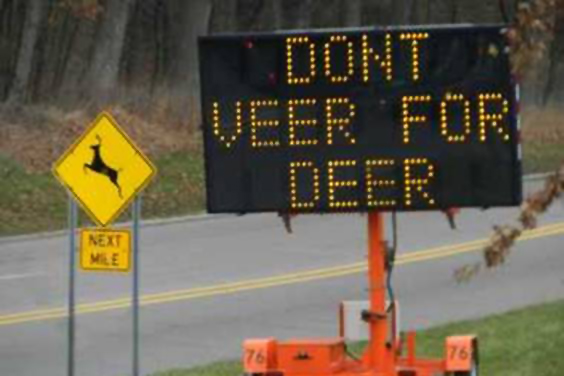Ask an Expert: Deer in the Headlights – Seven Things You Can Do to Reduce the Risks
 Utah is home to three members of the deer family — mule deer, moose and elk.
Utah is home to three members of the deer family — mule deer, moose and elk.
In the spring and summer, deer typically inhabit higher elevations, then move to lower elevations in the fall and winter as snow depths increase. It is generally during these seasonal migrations on winter ranges that the potential for deer-human conflicts occur.
When these annual migrations occur, deer must often cross highways that transect their migration corridors. These migration movements typically peak at night, and with diminished hours of light in the winter, the risk of drivers encountering deer while commuting increases.
As deer settle in for winter, additional conflicts may occur as they seek forage in the backyards or parks of urban areas that now dot their once-traditional winter ranges. The magnitude of these conflicts can increase when winter snows come early and cold temperatures persist longer in the spring. Under these scenarios, deer may become bolder as hunger overrules their fear of humans; and many humans, out of compassion for their plight, resort to feeding deer in their backyards.
When these circumstances occur in concert, they can put deer and humans on a course that often translates into increased deer-vehicle collisions, more deer damage in urban and rural landscapes and ultimately more dead deer. More dead deer may translate into long-term declines in native deer populations.
The solution to this problem will require each human inhabitant in deer country to do his or her part. Consider these tips.
1. Watch for deer-crossing signs. These signs have been strategically placed in areas to warn motorists that deer regularly cross the roads. Research conducted by the Berryman Institute at Utah State University has shown that most motorists are often oblivious to these signs because they frequently travel the route and do not see deer.
2. Slow down. This research also showed that if people drove the speed limit and the deer- crossing signs also had warning lights and flagging during migration periods, the number of deer-vehicles accidents was significantly reduced. Drive slower at night, especially when you see deer along the road.
3. Scan the side of the road to watch for moving deer. Remember, deer often travel in groups, so the deer you hit may not be the one you see, but the one following it.
4. If a collision with a deer is unavoidable, do not swerve. If you swerve at high speeds, you increase the risk of losing control of your vehicle and crossing into oncoming traffic.
5. While driving at night, use you high beams as much as possible. This will increase your vision field.
6. When traveling a multi-lane road, use the inside or passing lane when possible. This will increase your field of vision and afford you more reaction time. Remember to be cognizant of other traffic around you.
7. And finally – remember to drive the speed limit and buckle up.
Answer by: Terry Messmer, Utah State University Extension wildlife specialist


 Utah 4-H & Youth
Utah 4-H & Youth